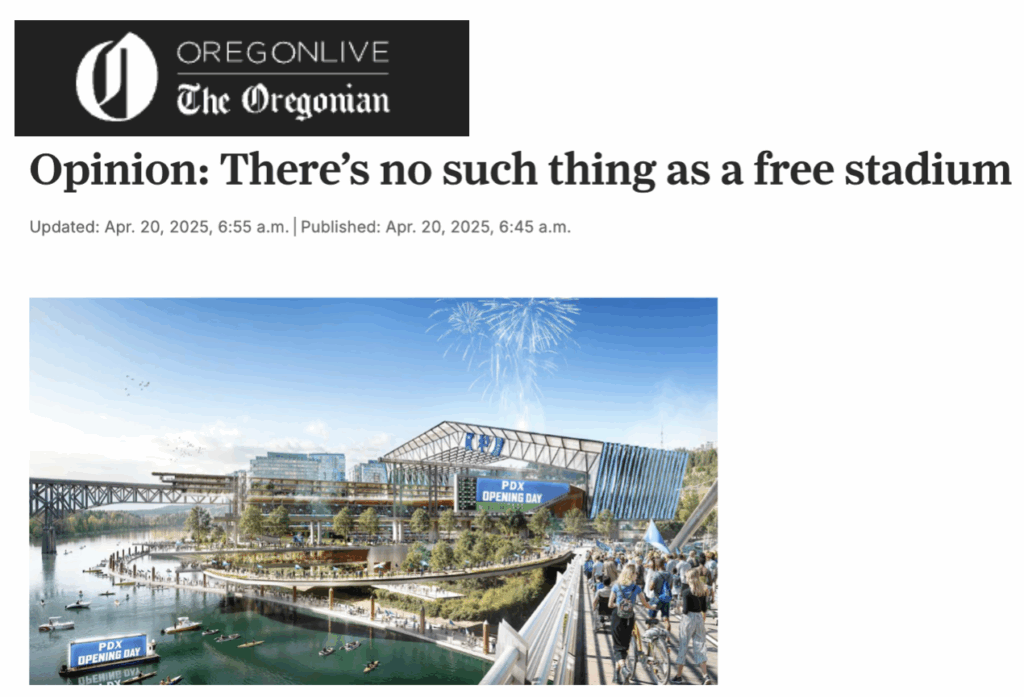What City Observatory Did This Week
Portland celebrates Earth Day by dropping billions on wider freeways!
Despite legal commitments to reduce greenhouse gas emissions, Oregon’s transportation emissions have increased 5% since 2013, directly contradicting Portland’s Climate Action Plan.
The irony is stark: On Earth Day, Oregon is advancing three major freeway expansion projects totaling nearly $12 billion – a complete reversal of Portland’s environmental legacy. Five decades ago, the city gained national recognition for removing a downtown freeway and replacing it with riverfront parks.
ODOT’s highway expansion plans violate state-mandated greenhouse gas reduction requirements. The science is clear: widening highways simply induces more demand, creating proportionally more traffic and emissions without solving congestion.
This represents a fundamental contradiction. If Portland was wise enough to stop building freeways 50 years ago when environmentalism was in its infancy, why can’t we make the same smart choice today when climate change presents an even more urgent challenge?
Must Read
A statistical profile of community divisions in Baltimore. The Baltimore Banner has an excellent offering of data journalism that documents the deep racial divides in the city and how much they’ve changed (and how little they’ve changed) in the past couple of decades. The Banner focuses on changes since the death of Freddy Gray at the hands of police in 2015. It offers a multi-dimensional picture looking at crime, arrests, housing vacancy and demolition and segregation.
One thing that is particularly striking is how persistent racial segregation is in Balitmore. It’s still the case that more than three-quarters of the city’s Black residents live in majority Black neighborhoods, and that about two-thirds of its white residents live in majority white neighborhoods. At best, this racial polarization is declining only very slowly.
The problem with corridor housing. Mike Eliason offers a powerful critique of a well-meaning but problematic suggestion to upzone areas along multi-lane roads for more apartments. One tempting idea for increasing density is to allow upzoning of strip malls and other highway-adjacent parcels (the theory being, in part, that there will be less NIMBY opposition to apartments in such locations). Advocates who call this a “Grand Boulevard” approach have done some back of the envelope math to suggest that areas adjoining rights-of-way could accommodate lots of housing. But as Eliason points out, there are serious drawbacks to this idea:
Not only will this plan fail to move the needle on affordable housing – but the infinitesimally narrow swaths of land where affordable housing is allowed will put our most vulnerable residents directly into harm’s way on the loudest, most toxic, and dangerous streets in our region’s cities. From an equity, quality of life, and livability standpoint – I cannot imagine a plan less forward thinking and visionless than this. . . . The air pollution associated with motor vehicles is associated with lung cancer, cardiovascular disease, stroke, asthma, COPD, diabetes, and mental health conditions.
While under-utilized commercial sites may be suitable locations for some additional housing–and we’ve seen redevelopment in former railyards and warehouse neighborhoods in many cities, replicating linear sprawl along highway corridors comes with real health, equity, and environmental baggage.
New Knowledge
It’s all about accessibility. David Levinson, perhaps the leading scholar and advocate of accessibility describes the arc of his work in this field in a readable essay. For decades, transport practice has focused on optimizing systems for mobility (generally, making cars move faster) rather than caring about improving access (making it easy for people to get to places they want to be). The result of mobility-dominating thinking is that we all travel a lot further, but thanks to sprawl, our destinations are further away than ever, and we live in a world that is far less accessible, especially to those who don’t own a car or can’t drive.
The technostructure of transportation planning has always relied on mobility measures (like “level of service” to guide investments. The de facto monopoly of those measures has been used to make highway expansions seem logical and scientific. Levinson and his colleagues have pioneered a new set of measures of accessibility–founded on careful research, which shows urban transportation system performance in a very different light than that presented, say, by the Texas Transportation Institute.
Los Angeles, San Francisco, and New York topped the list – not because they have free-flowing traffic (far from it), but because they have huge concentrations of jobs. Despite the reports of congestion given heavy airplay by the TTI Urban Mobility Scorecard (e.g. Schrank et al. 2015), the sheer density of opportunities meant a typical worker could reach a lot of destinations in a short time. This finding flipped the script: it showed that speed isn’t everything. A city can have slow traffic yet still offer high accessibility if jobs, services, and homes are close together. Conversely, a region can have fast highways but if everything is spread out, many people still won’t reach much within 30 minutes. This was a vivid demonstration of why accessibility (outcomes) trumps mobility (speeds)as a performance measure.
This essay provides a quick overview and a coherent guide of decades of scholarship in this field, and neatly links theory, measurement and practice. Levinson provides a readable, first-hand account from someone who has worked in the trenches of planning agencies, done original research in the field, and importantly, thought hard about how to translate and communicate these concepts to a wide audience. He’s right to claim we’ve made significant strides in making a “turn” to accessibility. Nonetheless, there are still many whose mindset is still locked into to mobility measures, and more needs to be done to complete the evolution in thinking.
David Levinson, The Accessibility Turn, April 7, 2025, https://www.transportist.net/p/the-accessibility-turn
In the News
The Oregonian published Joe Cortright’s analysis of Oregon’s proposed “jock-tax” to raise $800 million to pay for a Portland baseball stadium
Streetsblog USA republished City Observatory’s commentary, Congestion Pricing Works in Small Metros, Too.



